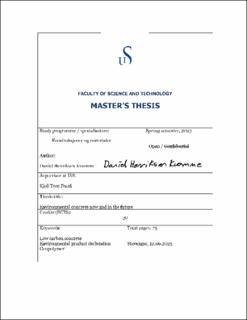| dc.description.abstract | This thesis investigates the emission profiles of two types of low carbon concrete: Schwenk’s low
heat cement and a geopolymer cement in development from Saferock. As a basis for comparison
a case scenario where a low carbon building is being built in Bergen is used. The emission
calculations are based on Environmental Product Declarations (EPD’s) published by EPD Norge
for each material required in the concrete.
The majority of emissions from concrete production is from clinker production, which can be
reduced by substituting parts of the binderwith SupplementaryCementitiousMaterials (SCM’s).
SCM’s are zero-emission byproducts and they are commonly used in cement production to reduce
emissions. Saferock uses instead mining waste as a binder to significantly reduce emissions
compared to traditional concrete types. Industries such as coal-burning power plants
and iron production generate carbon-neutral byproducts used in concrete, thus reducing the
cement requirement and lowering associated emissions. This offers an efficient wastemanagement
solution, although it may need to change if SCM’s are not classified as carbon neutral in
the future.
The study also considers the potential of using natural SCM’s from Iceland which originates
from volcanic eruptions as a sustainable solution. Carbon capture methods are being integrated
into the cement industry, despite their high energy demands. These technologies are
only beneficial when the total emissions captured are less than those produced from increased
energy production. Such solutions are viable in regions like Norway where hydropower is the
main energy source. The introduction of carbon taxes by the European Union (EU) to promote
carbon reduction measures is also explored, along with the conversion of captured CO2 into
Sustainable Aviation Fuels (SAF). Different CO2 storage solutions such as Carbfix in Iceland and
Equinor’s depleted oil and gas fields in Norway are investigated.
The results show that when comparing CO2 emissions from Saferock’s geopolymer concrete
and Schwenk’s low heat concrete, Saferock’s concrete reduces emissions by 65.23% (excluding
transportation and reinforcement) and by 43.65% when these factors are included. This marks
geopolymer cement fromSaferock as a superior choice in terms of CO2 emissions for lowcarbon
construction. | |
